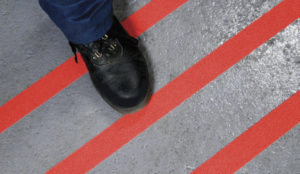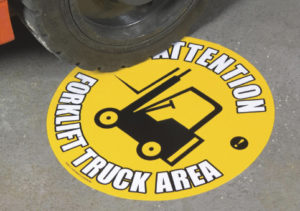OSHA & ANSI Color Standards for Safety Tape and Signs in the Workplace
By: Chris Meacher, Contributor
OSHA & ANSI color standards exist to help businesses in the U.S. make good decisions when it comes to marking their facilities for maximum efficiency and, more importantly, safety. There are resources available to help guide such businesses in making logical choices when applying floor marking and anti-slip tape in facilities.
OSHA & ANSI color standards guides hope to make it easier for these businesses to mark out warehouses, factories, distribution centers or any other facility that requires floor demarcation.
Depending on your safety tape requirements in your workplace, you can apply OSHA & ANSI color standards to all floor markings or choose select areas to suit your optimization and safety needs within the workplace.
The OSHA & ANSI uses for color standards are detailed below:
Red: Signals danger and relates to risk of fire. In relation to fire, red denotes areas where firefighting equipment is stored to highlight a fire exit (often red/white hazard markings) or marks an area, such as a hatch, that must remain clear at all times.
For traffic signage, red will warn people or vehicles to stop, possibly due to a busy throughway.
Other examples include emergency stop switches, buttons and bars on machines. Also, containers containing flammable liquids and confined space hazards.
Yellow: Denotes areas where caution must be taken. Use yellow for aisles, walkways and docking bays where there are exposed edges such as ledges and curbs. Often these routes will also be through or part of a working process, ensuring that people are kept aware of any potential hazards, such as forklifts.
Yellow is also used to mark physical, and sometimes static objects so they cannot be missed. These could include trip and striking hazards, and objects you could be caught in between.
Mark areas with yellow restrictions, such as construction areas or locations where only authorized personnel are allowed.
Blue: Blue is used to mark out important information in factories and warehouses. These notices can remind employees of best work practices, strict rules, overhead clearance in given areas and designated smoking and non-smoking areas.
Blue is also used to zone equipment that is out of order or work that is part of a process.
Green: The color green is used in the workplace for safety related information or medical equipment, such as first aid kits and eye wash stations. For safety information, examples are general sanitation reminders and guidelines and notify employees about potential hazards, best practices or safety measures.
Orange: Orange is used as a color to mark out warnings, often in areas where static or moving vehicles or machinery are in operation. Orange can be used in place of red to warn about a hazard that can result in death or serious injury, but the overall risk isn’t severe enough for red signs signaling danger.
Examples are exposed and moving machine parts, construction zones, low clearance levels and electrical hazards.
Black/Yellow: Areas that are potential health hazards or must be traversed with caution are often marked with black/yellow hazard markings. Often areas under maintenance or storing dangerous chemicals would feature these color markings clearly.
Red/White: As previously mentioned, you will find this color combination marking areas that need to be kept clear. Emergency access or electrical points with these markings are easily seen, helping people use them effectively and safely.
Adhering is Key
Variation is always possible depending on working practices, but it is advisable to stick to these guides as best as possible. As these colors have seemingly gained an almost universal understanding when used in the correct areas, to stray too far could have detrimental effects.
Simply color-coding objects or applying various forms of safety tapes in relevant colors can be enough to warn employees or guests. If this is not enough, then signs with messages (symbols, text or a combination of the two) applied in prominent positions will be very effective.
Combining color standards with anti-slip tape is also a cost-effective process. Combining slip prevention with markings to highlight hazards or restrictions can solve more than one problem with one process.
OSHA & ANSI standards employed correctly in the workplace can not only improve workplace efficiency but, most importantly, will reduce the likelihood of workplace accidents. Something that not only can cause death or injury to individuals but can have serious financial implications for a business.
By taking a little time to understand and prepare workplace safety color guidelines, you can save a lot of time in the long run. WMHS
Chris Meacher is the Marketing Manager with over ten years of experience for Heskins LLC, a safety tape manufacturer based in Butler, PA (https://heskins.com).





